When venturing into the vibrant and often volatile world of Asian markets, it's crucial to be aware of the hidden risks that can significantly impact your investment portfolio. As someone who has navigated these waters, I can attest that while the potential rewards are substantial, the pitfalls are just as real.
Geopolitical Tensions and Regulatory Hurdles
One of the most significant yet often overlooked risks is geopolitical tension. The recent conflicts, such as Russia's invasion of Ukraine, have shown us how quickly global events can ripple through financial markets. In Asia, similar tensions can arise from disputes over territories or trade policies. For instance, the South China Sea disputes can affect trade routes and investor confidence, leading to market volatility.
Local regulations can also be a major hurdle. In countries like Turkey, new regulations aimed at stabilizing the local currency can lead to time-consuming administrative processes and even trapped cash. Imagine having to navigate through a maze of regulations just to repatriate your funds or settle invoices in a foreign currency. This is a reality many investors face in emerging markets, where local authorities often prioritize the use of local currencies over international ones.
Economic Vulnerabilities
The economic health of emerging markets in Asia is closely tied to global trade and commodity prices. When global growth slows down, these countries feel the pinch, especially if they have significant debt denominated in US dollars. A stronger dollar makes it more expensive for them to service their debt, which can threaten their creditworthiness. This is why the trend of "de-dollarization" is gaining traction, with countries like China and India encouraging the use of local currencies in international transactions.
For example, China has removed several requirements for cross-border RMB payments, making it easier for Chinese companies to use the RMB when doing business overseas. This not only reduces currency exposure but also aligns with the broader strategy of reducing dependence on the US dollar.
Taxation and Currency Flows
Tax regulations can be another hidden risk. In Brazil, for instance, there is a Financial Operation Tax (IOF) on exchanging local currency, which can add unexpected costs to your transactions. Understanding these tax implications is crucial to avoiding surprises that can eat into your profits.
Currency flows are also critical. The way funds move through different banks and intermediary banks can affect the liquidity and availability of your money. After sanctions were imposed on Russia, the Russian ruble became less liquid, and this had a ripple effect on other countries, including Kazakhstan. Ensuring you have a clear understanding of the currency flow and the banks involved can save you a lot of trouble down the line.
Market Volatility and Concentration Risks
Asian markets are known for their volatility, and this can be exacerbated by concentrated stock positions. While concentrated investments can generate substantial wealth, they also come with a high risk of dramatic losses. In Asia, where innovation and disruption are rampant, sectoral shifts and regulatory changes can quickly turn winners into losers.
For instance, China's recent regulatory push against technology companies has shown how quickly fortunes can change. Companies that were once darlings of the market can find themselves on the wrong side of regulatory changes, leading to significant losses for investors.
Leveraged Investments and Volatility Drag
Leveraged ETFs, which use margin or derivatives to amplify returns, can be particularly risky in volatile markets. While they offer the promise of outsized gains, they also magnify losses. In periods of market downturn, these ETFs can post losses of 60% or more, making them a double-edged sword for investors.
The carry trade, which involves borrowing cheaply in a low-rate currency to invest in riskier assets denominated in a higher-rate currency, is another strategy that can backfire. Japan's recent interest rate hike, for example, made the carry trade less appealing, leading to market volatility as traders unwound their positions.
Diversification and Defensive Positioning
Given these risks, diversification is key to protecting your portfolio. Investing in a mix of assets, including defensive stocks and bonds, can help mitigate losses during market downturns. The classic 60/40 portfolio, which was once thought to be dead, has shown resilience in recent market dislocations. Bonds have once again proven to be a defensive asset, providing a positive return even when stocks were falling.
In Japan, for instance, defensive companies like Kao and KDDI have benefited from a strengthening yen, highlighting the importance of currency unhedged holdings in certain market conditions.
Global Monetary Policy and Local Market Dynamics
Global monetary policy changes can also impact Asian markets significantly. When the US Federal Reserve hikes interest rates, it can cause stress in emerging markets, particularly those with dollar-denominated debt. This can lead to currency depreciation, higher inflation, and tighter monetary policy, all of which can be detrimental to local markets.
In contrast, when global growth is strong and commodity prices are rising, emerging markets tend to perform well. However, this environment is not always stable, and investors need to be prepared for sudden changes.
Personal Experience and Market Insights
From my own experience, I've learned that navigating Asian markets requires a deep understanding of local dynamics and global trends. It's not just about looking at the big picture but also about paying attention to the small details that can make or break your investments.
For example, understanding the intricacies of local regulations and tax laws can save you from unexpected costs. Knowing how currency flows work and which banks are involved can ensure that your funds are liquid and accessible.
Conclusion
Investing in Asian markets is a thrilling yet challenging endeavor. While the potential for growth is immense, the hidden risks are just as real. By understanding geopolitical tensions, local regulations, economic vulnerabilities, taxation, and market volatility, you can better protect your portfolio.
Diversification, defensive positioning, and a keen eye on global monetary policy and local market dynamics are essential strategies for navigating these waters. Remember, it's not just about the big wins but also about avoiding the big losses. With the right approach, you can harness the power of Asian markets while minimizing the risks that come with them.






